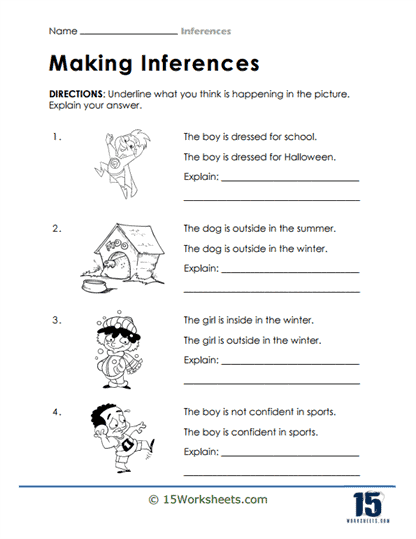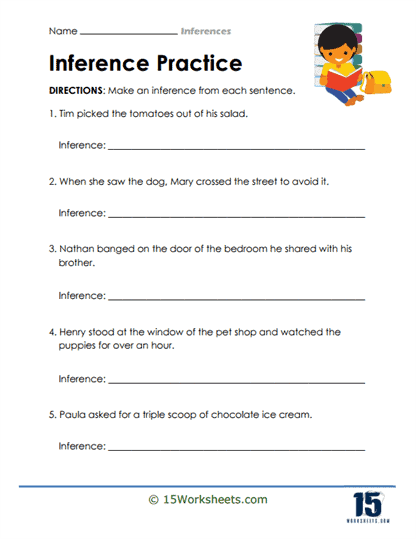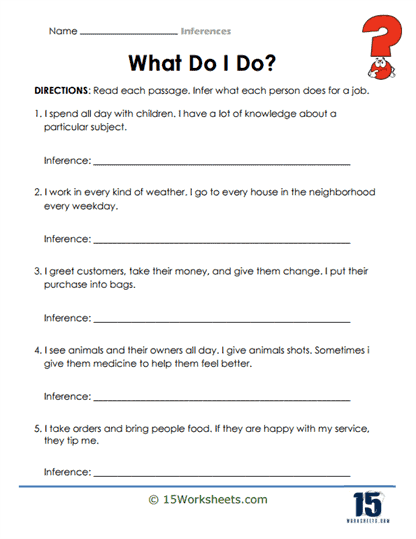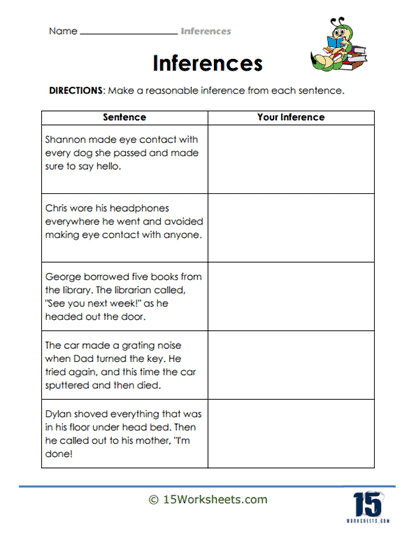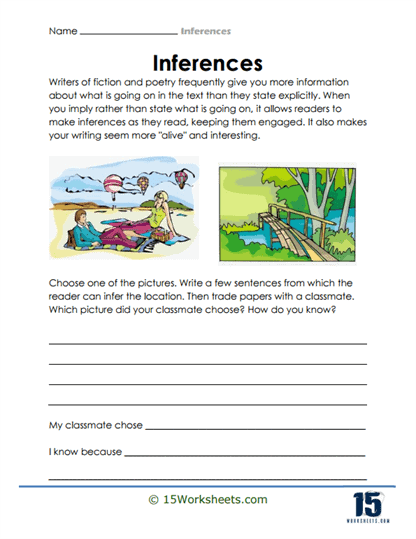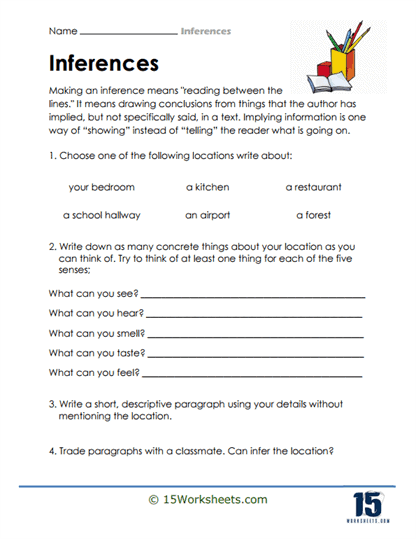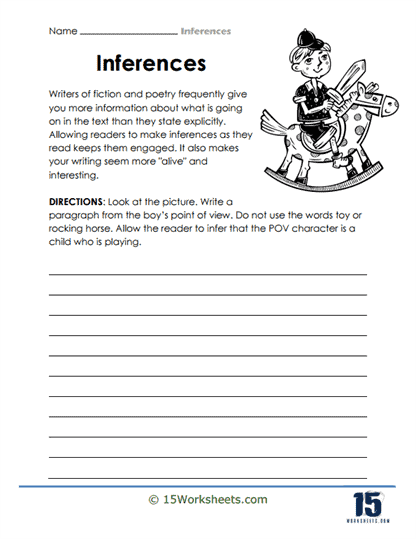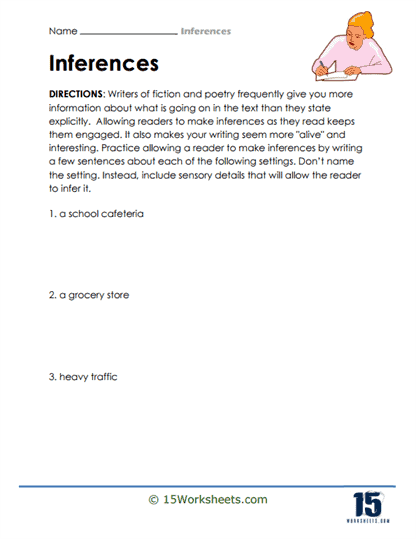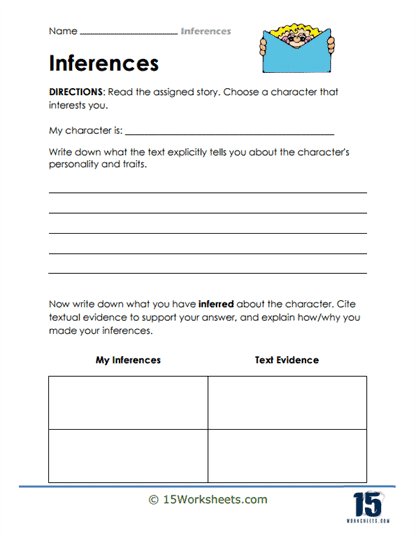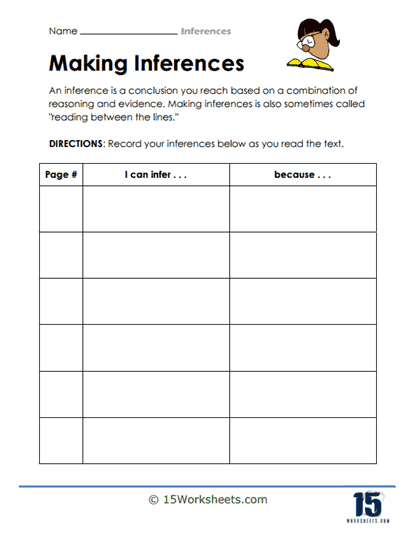Inferences Worksheets
All About These 15 Worksheets
Imagine you’re sitting down to read a new story. As you turn the pages, you begin to realize something interesting: the story isn’t spoon-feeding you all the details. Instead, it’s leaving subtle hints, making you work a little harder to understand the full picture. It doesn’t always tell you directly what’s going on. You might not know exactly what the weather is like or how the characters are feeling, but you start piecing together the clues. This is where the magic of inference comes into play. Inferences allow you, the reader, to step into the role of a detective, picking up on these subtle clues and connecting the dots between the text and what you already know.
Making inferences is a skill that goes beyond simply reading words on a page. It’s about actively engaging with the text, drawing conclusions that are not stated outright. Picture yourself watching a movie scene where a character walks into a room, drenched, and hangs up a soaked raincoat. The movie never tells you it’s raining, but you can easily figure that out because you’ve seen rain before, you know what wet clothes look like, and you connect those clues to draw a reasonable conclusion. This is exactly how making inferences works when you’re reading.
Inference worksheets are designed to sharpen this essential skill. They provide short passages, sentences, or even images, and ask you to dig a little deeper to find meaning that isn’t spelled out for you. The questions that accompany these worksheets don’t simply ask you for the facts or straightforward answers. Instead, they challenge you to think critically, to piece together the story based on the information given and your own background knowledge. It’s as though you’re given a puzzle with half the pieces missing, and you have to use your imagination and reasoning to complete it.
Consider this example: you come across a sentence in a worksheet that reads, “Sarah came inside, her clothes dripping, and she hung her soaked raincoat on the hook.” The text doesn’t directly say what the weather was like outside. But when asked, “What was the weather like?” you can infer that it was raining, based on Sarah’s drenched clothing and soaked raincoat. The worksheet is asking you to take what’s written, combine it with what you know about rain, and arrive at a logical conclusion.
Similarly, inference worksheets might ask you to figure out how characters are feeling, even when their emotions aren’t explicitly stated. Imagine reading the sentence, “Mike slammed the door and stormed up to his room.” The sentence doesn’t tell you how Mike is feeling, but from his actions-slamming the door and storming off-you can infer that he is angry or upset. These kinds of exercises help students move beyond surface-level reading to truly engage with the text on a deeper level.
Inference is not about guessing wildly. It’s an exercise in thoughtful reasoning. You’re not just making random assumptions but are connecting the dots between what the text says and what you already know from your own experiences. This requires practice, and like any skill, the more you practice making inferences, the better you become at it. This is where inference worksheets become an invaluable tool-they give you a structured way to practice, helping you sharpen this essential reading skill over time.
The inference worksheets you’re working with focus on more than just developing your ability to read between the lines. They play a crucial role in building several core skills that are vital for both academic success and life in general. The first of these skills is reading comprehension. By requiring you to extract meaning that goes beyond the literal text, these worksheets encourage you to engage deeply with what you read. Whether it’s through short passages, pictures, or detailed scenarios, you’re encouraged to use context clues and prior knowledge to infer details that aren’t immediately obvious. This process significantly enhances your overall comprehension by pushing you to pay attention to the subtleties in the text or images.
In addition to reading comprehension, inference worksheets are excellent at cultivating critical thinking and reasoning skills. When you’re presented with a situation that doesn’t reveal the whole story, you must rely on logic and reasoning to fill in the gaps. This ability to infer meaning based on partial information is an essential aspect of critical thinking. It’s not just about reading, it’s about thinking through problems, connecting various pieces of information, and forming logical conclusions-skills that will serve you well beyond the classroom.
Another key benefit of practicing with inference worksheets is the development of contextual understanding. Many worksheets ask you to infer information based on specific contexts. For example, you might need to infer the time of day based on a description of events or figure out a character’s occupation based on subtle clues. This requires you to pay close attention to contextual details, a skill that is incredibly useful in everyday life. Whether you’re interpreting social situations or analyzing information, being able to understand context is crucial.
Interestingly, some inference worksheets also focus on visual literacy. This means that instead of working solely with written passages, you might be asked to infer meaning from images. You could be presented with a picture of a person standing next to an open window with wind blowing through their hair, and asked to infer what the weather might be like. These activities strengthen your ability to interpret non-verbal cues, which is especially important in our increasingly multimedia-driven world. Being able to draw meaning from both text and images broadens your overall literacy skills and helps you become a more versatile reader and thinker.
Beyond comprehension and critical thinking, inference worksheets also contribute to the development of expressive language skills. Some of the exercises require you to not only make inferences but also explain your reasoning in writing. This forces you to clearly articulate your thoughts, a practice that enhances your ability to communicate effectively. Whether you’re writing an essay, having a conversation, or explaining your ideas, being able to express yourself clearly is a crucial skill that these worksheets help you develop.
One of the most effective aspects of these worksheets is their ability to cater to various learning styles. Some students learn best through visual aids, while others might excel when working with text. The beauty of inference worksheets is that they offer a range of activities that accommodate different preferences. For visual learners, there are tasks that involve analyzing images and inferring meaning from visual clues. For those who prefer text-based learning, there are passages and scenarios that require careful reading and critical thought. This variety ensures that all students can practice and refine their inferencing skills in a way that feels natural and engaging to them.
How Do You Make Inferences in What you Read?
Reading is not just a passive activity where words pass before your eyes, but a dynamic interaction between the reader and the text. At the heart of this interaction lies the ability to make inferences-drawing conclusions or uncovering hidden meanings based on what is explicitly written, and, crucially, on your own understanding of the world. Inferences bridge the gap between what the author provides and the deeper layers of meaning that exist beneath the surface, allowing you to engage more fully with what you read.
To make inferences is to become a detective of sorts, piecing together clues to form a coherent picture of a narrative, a character’s motivations, or the overarching message of a text. It requires careful reading, critical thinking, and the ability to connect the dots between what is said and what is implied. Developing this skill takes practice, but by breaking it down into manageable steps, it becomes a more natural part of the reading process. Let’s delve into how this works.
Reading Carefully
The first and most essential step in making inferences is to read carefully. It sounds obvious, but in today’s world of constant distractions, it can be easy to skim through a text without fully absorbing the details. Careful reading means slowing down and paying close attention to every word, phrase, and sentence. Descriptions, character interactions, and even seemingly insignificant details may hold the key to deeper understanding.
By reading attentively, you allow yourself the space to notice not only what the author is saying outright, but also what they may be hinting at. Is there a tension between a character’s actions and their words? Are there subtle shifts in tone or language that suggest something left unsaid? These are the kinds of questions that careful reading invites. In a way, this step is like gathering the raw materials-the facts-that you will later use to craft your inferences.
Finding the Hidden Meaning
Once you have carefully read the text, the next step is to identify clues. Think of the text as a puzzle, with each piece-descriptions, actions, dialogue, symbols-contributing to the larger picture. Authors rarely lay out everything plainly; instead, they scatter hints throughout the narrative, inviting you to dig deeper. These clues may be subtle-a character’s body language, a recurring image, or a moment of silence in a conversation. They are the elements that, while not immediately obvious, suggest that something more is going on beneath the surface.
For example, if a character consistently avoids eye contact during conversations, this might hint at feelings of guilt, shame, or insecurity. If a certain object keeps appearing throughout the story-a flower, a particular color, a specific phrase-it may symbolize something significant about the themes of the text. By recognizing these clues, you begin to gather the evidence you need to make informed inferences.
Connecting to Background Knowledge
Your ability to make inferences also relies on your own background knowledge. As readers, we don’t come to texts as blank slates; we bring with us our experiences, our understanding of human behavior, and our awareness of cultural, historical, and social contexts. This personal knowledge helps us interpret the clues we find and draw conclusions that go beyond the literal meaning of the words on the page.
For instance, if you are reading a historical novel set during World War II, your understanding of that time period-its tensions, conflicts, and emotional landscape-will inform how you interpret the characters’ actions and motivations. Similarly, if a text deals with social issues like discrimination or inequality, your knowledge of these topics will shape the inferences you make about the characters’ struggles and the message the author is trying to convey. In this way, reading becomes an interactive process where your prior knowledge plays an integral role in deepening your comprehension.
Asking Questions
Another essential step in making inferences is to ask questions as you read. This keeps your mind actively engaged with the material, prompting you to think critically about what is happening in the text and why. Asking questions about characters, events, and motivations encourages you to consider possibilities beyond what is directly stated.
For instance, if a character makes a surprising decision, ask yourself why. What might be motivating them? Are there hidden fears, desires, or pressures influencing their choices? When an event unfolds in an unexpected way, ask what the broader implications might be for the story. These questions help you think beyond the surface and push you toward drawing inferences that enhance your understanding of the text.
Uncovering Recurring Themes and Motifs
As you read, patterns often emerge, and recognizing these patterns is key to making inferences. Repeated images, symbols, or themes can provide a roadmap to understanding the deeper meanings within a text. Authors often use repetition deliberately to emphasize important ideas or to draw connections between different parts of the narrative.
For example, if a novel repeatedly refers to light and darkness, this could suggest a deeper exploration of good versus evil, knowledge versus ignorance, or hope versus despair. If a character continually engages in self-destructive behavior, it may be a clue to their inner turmoil or unresolved trauma. By identifying these patterns, you begin to see the structure beneath the story and can make more informed inferences about the themes and messages the author is conveying.
Evaluating Evidence
Once you’ve gathered clues and started forming inferences, it’s important to evaluate the evidence that supports them. This step ensures that your inferences are grounded in the text and not simply based on assumptions or speculation. Look for direct quotes, descriptions, and events that validate your conclusions. Does the text provide enough support for the inferences you’re making, or are you stretching the evidence too thin?
For example, if you infer that a character is hiding a secret, look for textual evidence that supports this idea. Do their actions suggest deception? Are there moments where they avoid answering direct questions? By grounding your inferences in the text, you ensure that your interpretations are logical and well-supported.
Revising as You Read
As you continue reading, formulate your inferences based on the clues, patterns, and evidence you’ve gathered. However, remember that inferences are not set in stone. As the story progresses and new information emerges, you may need to revise or refine your initial conclusions. Be open to testing your inferences against the unfolding events of the narrative. Sometimes, the text will confirm your suspicions, and other times, it may challenge them, requiring you to adjust your interpretation accordingly.
This process of revision is a key aspect of critical reading. It’s a reminder that inferences are part of an ongoing dialogue between you and the text-a dialogue that evolves as new details come to light.





